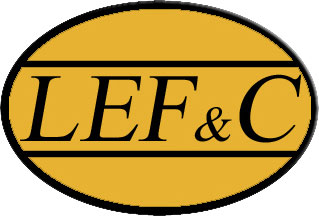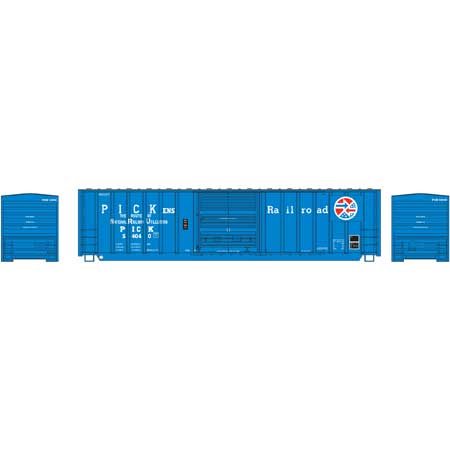Model Information: This model was first produced by Kadee in February of 1981. It is a model of a 50 Foot Steel Rib-Side Single Sliding Door Boxcar. Specifically, this Micro-Trains body style models the FMC 50' 5077 Single Sliding Door prototype. It is also used by Micro-Trains to model Pullman Standard 50' boxcars. Hence on some releases, this car is labeled as a Pullman Standard and in other cases it is labeled as an FMC boxcar, and it also is frequently labeled as a '50' Rib Side Box Car[sic]' with no mention of prototype whatsoever. It appears to be closest to the FMC 5077 boxcar prototype (from the 1970s) in any event. These models can appear with any one of multiple different sliding door types. The doors for this model are operating ones (cool!).
Prototype History: In the 1970's with the growth of the Per Diem business model, FMC produced a series of 50 foot box cars in different configurations. The single-sliding-door configuration is one of the best known and used widely by many different railroads. These cars were produced using the Gunderson metal works which FMC had acquired in 1965. In late 1975, FMC began producing a 5,077-cubic-foot Plate B box car for IPD and Railbox service. FMC's 5077s have seven panels to either side of the 10-foot door, an X-panel roof, and non-terminating ends that are slightly different from those used on FMC's earlier cars. Note how the sidesill is notched all the way back to the bolsters, a key feature of FMC's mature design.
The main difference between the 5077 cu. ft cars built by FMC vs the 5277-5347 cu. ft cars built by the same manufacturers is the overall height of the car, the smaller 5077 cars were Plate B while the larger 5277-5347 cars were Plate C. Over 4,300 cars were produced from 1975-1979 by FMC's Portland, Oregon plant. The cars were delivered in numerous colorful shortline paint schemes, as well as the nationwide car pool fleet of Railbox. Many secondhand cars were later seen in Class 1 railroads and large leasing company fleets under additional shortline reporting marks.
The main difference between the 5077 cu. ft cars built by FMC vs the 5277-5347 cu. ft cars built by the same manufacturers is the overall height of the car, the smaller 5077 cars were Plate B while the larger 5277-5347 cars were Plate C. Over 4,300 cars were produced from 1975-1979 by FMC's Portland, Oregon plant. The cars were delivered in numerous colorful shortline paint schemes, as well as the nationwide car pool fleet of Railbox. Many secondhand cars were later seen in Class 1 railroads and large leasing company fleets under additional shortline reporting marks.
Road Name History: The Lake Erie, Franklin, and Clarion Railroad (reporting mark LEF) was a fifteen mile long short line that ran from a Conrail connection at Summerville, Pennsylvania, to Clarion, Pennsylvania, the county seat of Clarion County, and included a short branch from Sutton to Heidrick. The road was incorporated in 1913 as a consolidation of several other railroads, the Pennsylvania Northern, Pennsylvania Southern, and the Pittsburgh, Clarion and Franklin, which itself was formed from the Pittsburgh, Summerville, and Clarion [which began operation in 1904 and was leased to the Pennsylvania Southern in 1910. Length peaked at about 80 miles of track in around 1924. The corporate name was somewhat optimistic: the railroad never reached either Franklin or Lake Erie.
In the late 20th century, traffic included sand for Clarion's glass making plant, glass bottles, lumber, and outbound shipments of coal, some of it in unit trains from the extensive coal deposits around Clarion. Traffic also included brick from the Hanley Brick Plant in Summerville. The line ceased operation in the last decade of the 1900s due to a sharp decline in coal mining in the area. The track was taken up and the roadbed in now a hiking path. One of the railroad's cabooses had been used for several years as a Chamber of Commerce roadside information booth across the highway from the local Wal-Mart, but has been removed and is now serving much the same purpose in the town of Foxburg on the Allegheny River, a few miles to the southwest.
The line's yard and engine facility were located in Clarion, just south of U.S. route 322 and behind many of the buildings of Clarion University of Pennsylvania, formerly Clarion State Teachers' College. A section house was located at the siding to Hanley Brick, now Glen-Gary in Summerville. Motive power in the line's final years was four EMD MP15DC switchers #25-28, which replaced two earlier EMD SW1500s #23-24. During the final years when steam locomotives powered LEF&C trains, most of the road's locomotives were 2-8-0's which had been acquired second hand from other railroads.
In the late 20th century, traffic included sand for Clarion's glass making plant, glass bottles, lumber, and outbound shipments of coal, some of it in unit trains from the extensive coal deposits around Clarion. Traffic also included brick from the Hanley Brick Plant in Summerville. The line ceased operation in the last decade of the 1900s due to a sharp decline in coal mining in the area. The track was taken up and the roadbed in now a hiking path. One of the railroad's cabooses had been used for several years as a Chamber of Commerce roadside information booth across the highway from the local Wal-Mart, but has been removed and is now serving much the same purpose in the town of Foxburg on the Allegheny River, a few miles to the southwest.
The line's yard and engine facility were located in Clarion, just south of U.S. route 322 and behind many of the buildings of Clarion University of Pennsylvania, formerly Clarion State Teachers' College. A section house was located at the siding to Hanley Brick, now Glen-Gary in Summerville. Motive power in the line's final years was four EMD MP15DC switchers #25-28, which replaced two earlier EMD SW1500s #23-24. During the final years when steam locomotives powered LEF&C trains, most of the road's locomotives were 2-8-0's which had been acquired second hand from other railroads.
Brand/Importer Information: Micro-Trains is the brand name used by both Kadee Quality Products and Micro-Trains Line. For a history of the relationship between the brand and the two companies, please consult our Micro-Trains Collector's Guide.
Manufacturer Information:  Micro-Trains Line split off from Kadee Quality Products in 1990. Kadee Quality Products originally got involved in N-Scale by producing a scaled-down version of their successful HO Magne-Matic knuckle coupler system. This coupler was superior to the ubiquitous 'Rapido' style coupler due to two primary factors: superior realistic appearance and the ability to automatically uncouple when stopped over a magnet embedded in a section of track. The success of these couplers in N-Scale quickly translated to the production of trucks, wheels and in 1972 a release of ready-to-run box cars.
Micro-Trains Line split off from Kadee Quality Products in 1990. Kadee Quality Products originally got involved in N-Scale by producing a scaled-down version of their successful HO Magne-Matic knuckle coupler system. This coupler was superior to the ubiquitous 'Rapido' style coupler due to two primary factors: superior realistic appearance and the ability to automatically uncouple when stopped over a magnet embedded in a section of track. The success of these couplers in N-Scale quickly translated to the production of trucks, wheels and in 1972 a release of ready-to-run box cars.
Micro-Trains Line Co. split off from Kadee in 1990 to form a completely independent company. For this reason, products from this company can appear with labels from both enterprises. Due to the nature of production idiosyncrasies and various random factors, the rolling stock from Micro-Trains can have all sorts of interesting variations in both their packaging as well as the products themselves. When acquiring an MTL product it is very important to understand these important production variations that can greatly enhance (or decrease) the value of your purchase.
Please consult our Micro-Trains Collector's Guide

Micro-Trains Line Co. split off from Kadee in 1990 to form a completely independent company. For this reason, products from this company can appear with labels from both enterprises. Due to the nature of production idiosyncrasies and various random factors, the rolling stock from Micro-Trains can have all sorts of interesting variations in both their packaging as well as the products themselves. When acquiring an MTL product it is very important to understand these important production variations that can greatly enhance (or decrease) the value of your purchase.
Please consult our Micro-Trains Collector's Guide
Item created by: gdm on 2016-08-30 19:00:52. Last edited by George on 2024-01-26 20:29:02
If you see errors or missing data in this entry, please feel free to log in and edit it. Anyone with a Gmail account can log in instantly.
If you see errors or missing data in this entry, please feel free to log in and edit it. Anyone with a Gmail account can log in instantly.










